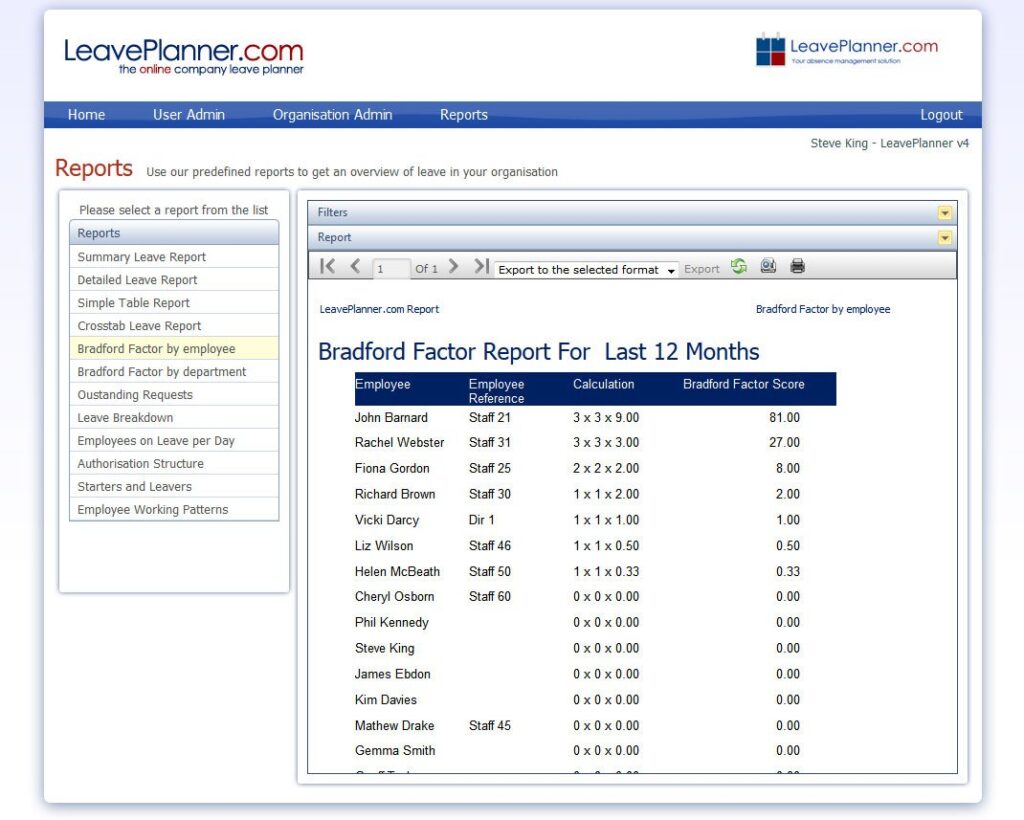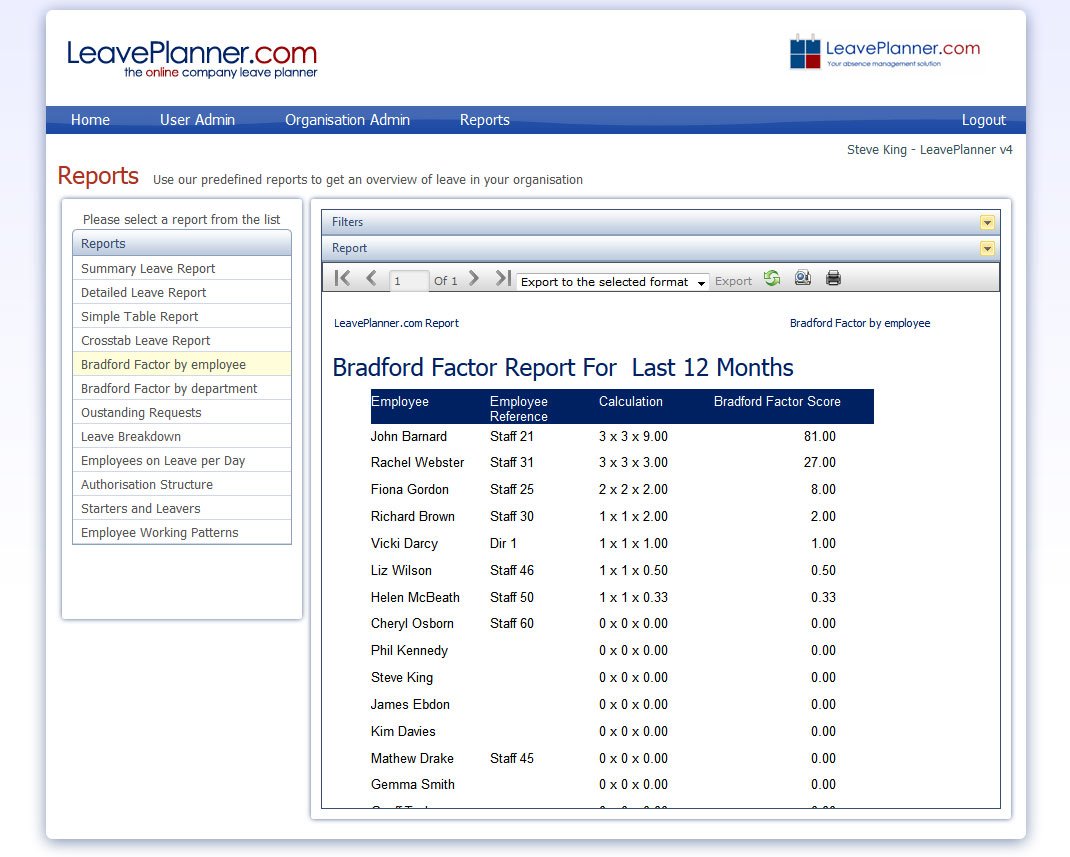
Understanding Bradford Factor Scores: A Comprehensive Guide for HR Professionals
In the realm of human resources, managing employee absenteeism is a persistent challenge. One tool frequently employed to quantify and address this issue is the Bradford Factor score. This guide provides a comprehensive overview of the Bradford Factor score, its calculation, interpretation, and appropriate application within an organization. We will delve into the nuances of using this metric effectively, while also acknowledging its limitations and potential drawbacks.
What is the Bradford Factor?
The Bradford Factor, also known as the Bradford Index, is a formula used by HR departments to measure employee absenteeism. It’s based on the theory that frequent, short-term absences are more disruptive to a business than longer absences. The core idea is that multiple instances of absence, even for short durations, can significantly impact productivity, workflow, and overall team morale.
The Bradford Factor score is calculated using the following formula:
B = S² x D
Where:
- B = Bradford Factor score
- S = Total number of spells (instances) of absence
- D = Total number of days of absence
For example, an employee who takes 5 separate days off work over a year (5 spells) and is absent for a total of 5 days would have a Bradford Factor score of 125 (5² x 5 = 125). Another employee absent for one continuous block of 5 days would have a score of 5 (1² x 5 = 5). This highlights the emphasis the formula places on the frequency of absences.
Calculating the Bradford Factor Score: A Step-by-Step Guide
Calculating the Bradford Factor score is straightforward. Here’s a step-by-step guide:
- Determine the Period: Define the timeframe for the calculation. This is typically a rolling 12-month period or a fiscal year.
- Gather Absence Data: Collect accurate absence records for each employee, noting both the number of spells (separate instances of absence) and the total number of days absent.
- Apply the Formula: For each employee, calculate the Bradford Factor score using the formula B = S² x D.
- Analyze the Results: Review the calculated scores and identify employees with high scores.
- Set Thresholds: Establish clear thresholds for triggering further action, such as informal discussions, formal warnings, or other interventions.
Interpreting Bradford Factor Scores
The interpretation of Bradford Factor scores varies depending on the organization’s policies and tolerance for absenteeism. Generally, higher scores indicate a greater disruption to the business. Many companies use a tiered system, where different score ranges trigger different actions.
For instance:
- Low Score (e.g., below 50): Generally considered acceptable. No specific action required.
- Medium Score (e.g., 51-200): May trigger an informal discussion to understand the reasons for absence and offer support.
- High Score (e.g., 201-650): Could lead to a formal warning or performance improvement plan.
- Very High Score (e.g., above 650): May result in more serious disciplinary action, up to and including termination of employment.
It’s crucial to remember that these are just examples, and the specific thresholds should be tailored to the organization’s specific needs and industry standards. It is also important to consider the context behind the absences. [See also: Managing Employee Performance]
Benefits of Using the Bradford Factor
The Bradford Factor score offers several potential benefits for organizations:
- Identifies Problematic Absence Patterns: It helps identify employees whose frequent short-term absences are causing disruption.
- Provides Objective Data: It offers a quantifiable metric for assessing absenteeism, reducing subjectivity in absence management.
- Supports Fair and Consistent Application of Policies: It ensures that absence policies are applied consistently across the organization.
- Highlights Potential Underlying Issues: High scores can indicate underlying issues such as work-related stress, health problems, or personal difficulties.
- Reduces Absenteeism Costs: By addressing problematic absence patterns, it can help reduce costs associated with lost productivity, overtime, and temporary staff.
Limitations and Criticisms of the Bradford Factor
Despite its benefits, the Bradford Factor score has several limitations and has faced criticism:
- Doesn’t Consider Reasons for Absence: It treats all absences the same, regardless of the reason. An employee with a genuine medical condition requiring frequent short appointments will be penalized unfairly.
- Can Discriminate Against Employees with Disabilities: It may disproportionately affect employees with disabilities or chronic illnesses who require frequent medical appointments or have fluctuating health conditions.
- Focuses on Symptoms, Not Causes: It addresses the symptom of absenteeism rather than the underlying causes, such as poor management, lack of engagement, or a toxic work environment.
- Can Lead to Presenteeism: Employees may come to work when they are sick to avoid triggering the Bradford Factor, potentially spreading illness and reducing productivity.
- May Not Be Suitable for All Industries: Its effectiveness may vary depending on the industry and the nature of the work.
- Risk of Misinterpretation: It’s crucial to understand the context behind the Bradford Factor score and avoid using it as the sole basis for disciplinary action.
Ethical Considerations When Using the Bradford Factor
When implementing and using the Bradford Factor score, it’s essential to consider the ethical implications. Transparency is paramount. Employees should be informed about the existence of the Bradford Factor, how it is calculated, and how it is used to manage absenteeism. [See also: Ethical HR Practices]
It’s also crucial to avoid using the Bradford Factor as the sole determinant for disciplinary action. Each case should be assessed individually, considering the reasons for absence, the employee’s overall performance, and any mitigating circumstances. Reasonable adjustments should be made for employees with disabilities or chronic illnesses, as required by law. Failing to do so can lead to legal challenges and damage the organization’s reputation.
Best Practices for Implementing the Bradford Factor
To maximize the effectiveness and minimize the potential drawbacks of the Bradford Factor score, consider the following best practices:
- Communicate Clearly: Explain the purpose of the Bradford Factor and how it will be used to employees.
- Set Realistic Thresholds: Establish thresholds that are fair and reasonable, taking into account the nature of the work and industry standards.
- Consider Context: Always consider the reasons for absence and any mitigating circumstances before taking action.
- Train Managers: Provide managers with training on how to use the Bradford Factor effectively and ethically.
- Review and Update Policies: Regularly review and update absence management policies to ensure they are fair, effective, and compliant with relevant legislation.
- Offer Support: Provide employees with access to resources and support to address underlying issues contributing to absenteeism, such as employee assistance programs (EAPs).
Alternatives to the Bradford Factor
Given the limitations of the Bradford Factor score, some organizations are exploring alternative approaches to managing absenteeism. These alternatives often focus on addressing the root causes of absence and promoting employee well-being.
Some alternatives include:
- Return-to-Work Interviews: Conducting thorough return-to-work interviews to understand the reasons for absence and offer support.
- Well-being Programs: Implementing well-being programs to promote employee health and reduce stress.
- Flexible Working Arrangements: Offering flexible working arrangements to improve work-life balance and reduce absenteeism related to personal commitments.
- Absence Case Management: Using a case management approach to address complex absence issues and provide individualized support.
- Focus on Employee Engagement: Creating a positive and engaging work environment to reduce absenteeism related to dissatisfaction or disengagement.
The Future of Absence Management
The future of absence management is likely to involve a more holistic and employee-centric approach. Organizations are increasingly recognizing the importance of addressing the underlying causes of absence and promoting employee well-being. Technology is also playing a growing role, with the emergence of sophisticated absence management systems that provide real-time data and analytics. These systems can help organizations identify trends, track absence patterns, and implement targeted interventions.
Conclusion
The Bradford Factor score can be a useful tool for managing employee absenteeism, but it should be used with caution and in conjunction with other approaches. It’s essential to understand its limitations, consider the ethical implications, and implement it in a way that is fair, transparent, and supportive of employee well-being. By focusing on addressing the root causes of absence and creating a positive work environment, organizations can reduce absenteeism and improve employee engagement and productivity. Remember that the Bradford Factor is just one piece of the puzzle, and a comprehensive absence management strategy requires a multi-faceted approach that prioritizes both organizational needs and employee well-being. Using the Bradford Factor score responsibly is key to its effective implementation. The Bradford Factor, when used judiciously, can contribute to a healthier and more productive workplace. The effective application of the Bradford Factor score requires careful consideration and a balanced approach. Understanding the nuances of the Bradford Factor score is crucial for HR professionals. Finally, always remember that the Bradford Factor is a tool, not a solution, and should be used in conjunction with other strategies. [See also: Building a Positive Workplace Culture]

